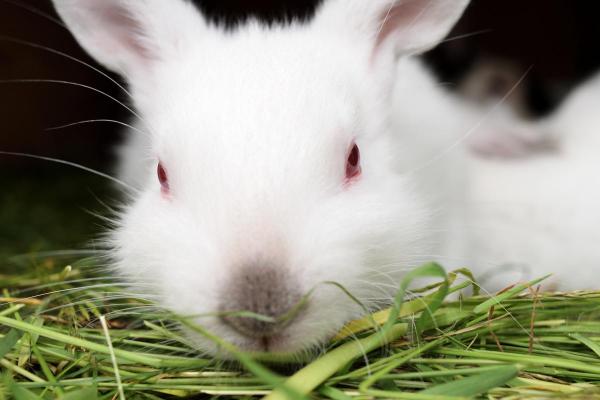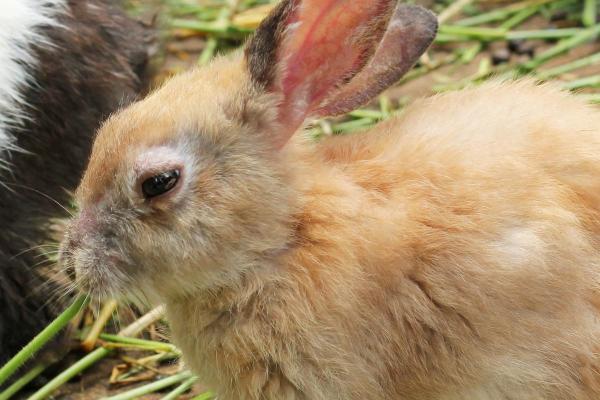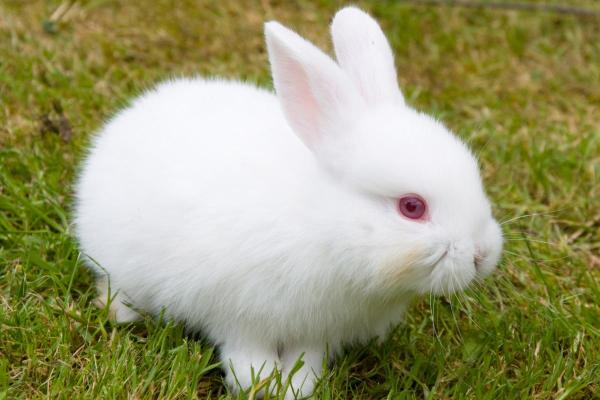
Red eyes in rabbits can be a natural trait for certain rabbit breeds, especially if they have white hair. As with most physical traits, it is a result of genetic conditioning passed down from previous generations. It should not cause a health problem for them or affect their wellbeing. There are some conditions where a rabbit can have red eyes due to a pathological issue such as conjunctivitis, the causes of which are varied. There are also conditions such as albinism which can lead to a white rabbit with red eyes.
At AnimalWised, we look at red eye in rabbits, looking at the causes and treatment of both pathological and non-pathological red-eye rabbits.
Conjunctivitis
Conjunctivitis is an inflammation of the conjunctiva, i.e. the thin mucus membrane on the inside of the eyelids. It can be limited to the sclera (the white of the eye) or also affect the inner surface of the eyelid. It is a relatively common disease and one of the main causes of red eyes in rabbits. It can happen at any age, although immunosuppressed rabbits are at a greater risk. It can be a primary or secondary disorder which causes red eye in rabbits.
Although conjunctivitis in rabbits is easily treatable, it can lead to serious health risks if it is neglected or reinfection occurs. The main causes of rabbit conjunctivitis include:
- Environmental causes: including allergens, such as dust, hay or pollen. It can also occur from direct contact with toxic substances.
- Infections: mainly those caused by viruses, especially those secondary to an infection of the respiratory tract. Bacteria are also pathogenic agents that can cause primary or secondary infection that leads to conjunctivitis.
- Dental causes: it is common for rabbits to develop conjunctivitis as a result of a problem in dental growth. The root of the teeth becomes inflamed and obstructs the outlet of the tear ducts, secretions and microorganisms accumulate in the duct and subsequent eye inflammation occurs. Rabbit teeth never stop growing, so we need to be very observant for abnormal teeth growth in rabbits.
- Foreign bodies: the introduction of dust or any other type of foreign body in the eyeball will cause the rabbit to have a red eye, developing conjunctivitis.
The symptoms of conjunctivitis in rabbits are mostly related to the inflammation itself, as well as secondary bacterial infections that can occur:
- Red and swollen conjunctivae on one or both eyes
- Constant tearing
- Mucopurulent discharge (usually bacterial infection)
- Buildup of pus can keep the eyelids closed
- Eye pain
- Fever in some cases
- General discomfort
- Appetite loss
Diagnosis is relatively straightforward. It is important to perform complementary tests, such as a complete hematology, especially in secondary cases.
Treatment of conjunctivitis in rabbits
Treatment of conjunctivitis in rabbits is based on eye drops or oral medication, but it will depend on the cause that leads to red eye in rabbits. For example:
- Allergies: antihistamines may be required, but it is most important to remove the allergen from the rabbit's environment. Although hay allergies are relatively rare in rabbits, they do occur. In these cases, an alternative feed and substrate should be purchased.
- Viral infections: there is no specific treatment, but the symptoms may be treated. Anti-inflammatory eyedrops, oral NSAIDs, antipyretics in case of fever, rest and hydration if the patient requires it.
- Bacterial infection: antibiotic therapy is used in bacterial infections. The veterinarian will be the one who determines the type of bacteria involved and will prescribe the corresponding antibiotic.

Entropion
Entropion in rabbits is defined as the inversion of the eyelid. It can be congenital or acquired, affecting one or both eyelids. In this case, the eyelashes cause constant irritation to the eyeball, so that conjunctivitis or corneal irritation later develops.
The diagnosis of entropion is relatively simple. Through clinical inspection in consultation and the experience of the veterinarian, it is an easily identifiable condition. Red eye in rabbits is usually one of the early signs.
Treatment of entropion in rabbits
In most patients, this condition can be corrected in the operating room, so surgery is necessary. This will need to be carried out by a veterinarian specialized in this species. In addition, surgical treatment must be accompanied by anti-inflammatory medication and eye drops while the architecture of the eye is reestablished.
Allergies
We have already mentioned allergies as a cause of conjunctivitis, but they can also cause general red eyes in rabbits. Environmental allergies are the most common form, resulting from pollen, dust or other allergens. This is often the case when the hutch is not cleaned properly or if improper products are used to clean it.
Rabbits can also develop food allergies which cause red eyes, although they are relatively uncommon in these animals. When this occurs, we will likely see other signs such as inflammation of the eyelids, hair loss around the eyes and mouth, as well as itching and even otitis. The vet will perform the necessary allergy tests to find the allergen that is causing that allergic reaction.
Treatment of allergies in rabbits
Treatment consists of eliminating the allergen that triggers the allergic response from the rabbit's body, whenever possible. Antihistamines may be required during the acute period. This should resolve the problem with red eye in rabbits.
Uveitis
Uveitis is one of the most common eye diseases in rabbits. It is defined as inflammation of the uvea, this being the vascular layer of the eye where we find the iris among other parts. The uvea mainly becomes inflamed by trauma or by infections.
One of the most prominent symptoms is red eyes in the rabbit. It is also common to observe excessive closing of the eye due to pain, excessive tearing and even opacity of the cornea.
Treatment of uveitis in rabbits
The treatment will depend on the underlying cause that results in the uveitis. For this reason, antibiotics, anti-inflammatories or even anti-parasitic drugs may be prescribed.
Learn about other symptoms of a sick rabbit in our related article.

Albinism
Albinism in rabbits is defined as a genetic condition in which the rabbit does not produce melanin. Melanin is the pigment responsible for the coloration of the rabbit's skin and hair. A white rabbit with red eyes may be the result of this melanin deficit. The coloration also extends to the skin and mucus membranes which can appear pink, in addition to the red eye in rabbits.
White bunnies with red eyes are much more sensitive to light, both solar and artificial. This is due to the lack of pigmentation in the eyes. They tend to hide when they are in a space with very bright or intense light. Likewise, they are more predisposed to suffer from certain health problems, such as loss of vision and hearing. For all these reasons, these bunnies need more care than those with normal melanin levels.
Treatment of albinism in rabbits
Albinism is not a disease and has no treatment because the rabbit is born with this genetic condition. With proper care, they can have a good quality of life and enjoy themselves like any other rabbit. Of course, in these cases it is even more important to go to regular veterinary check-ups in order to detect any health problem as soon as possible. We also need to ensure we provide appropriate sun protection as they are more predisposed to issues such as skin cancer.
Learn more about this condition with our article on albinism in animals.

Breeds of rabbits with red eyes
Some rabbits have red eyes because of their genetics, not because they are sick or albino. There are certain breeds of rabbits with red eyes where the presence of this coloration is normal. They include the following:
- New Zealand rabbit: this rabbit breed can present in different colors, but the one with the characteristic red eyes is white.
- Blanc de Bouscat: it is one of the largest rabbits that exist, weighing up to 5 kg. It is white, with a larger tail than other rabbit breeds and red or pink eyes.
- Californian rabbit: this is a white bunny with red eyes, but they are not completely white. They have a colorpoint pattern, meaning they have darker colors on the paws, ears, mouth and tail. The tone of this colorpoint pattern can be more or less dark depending on the place where they live.
As you can see, not all rabbits with red eyes suffer from a health problem. However, if your bunny does not belong to any of these breeds and you see redness in one or both eyes, go to the veterinary center as soon as possible.
Learn about other types of domestic rabbit with our guide to the various different rabbit breeds.

This article is purely informative. AnimalWised does not have the authority to prescribe any veterinary treatment or create a diagnosis. We invite you to take your pet to the veterinarian if they are suffering from any condition or pain.
If you want to read similar articles to Red Eye in Rabbits - Causes and Treatment, we recommend you visit our Eye problems category.